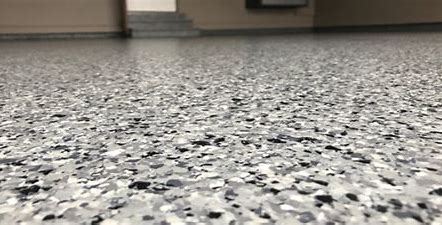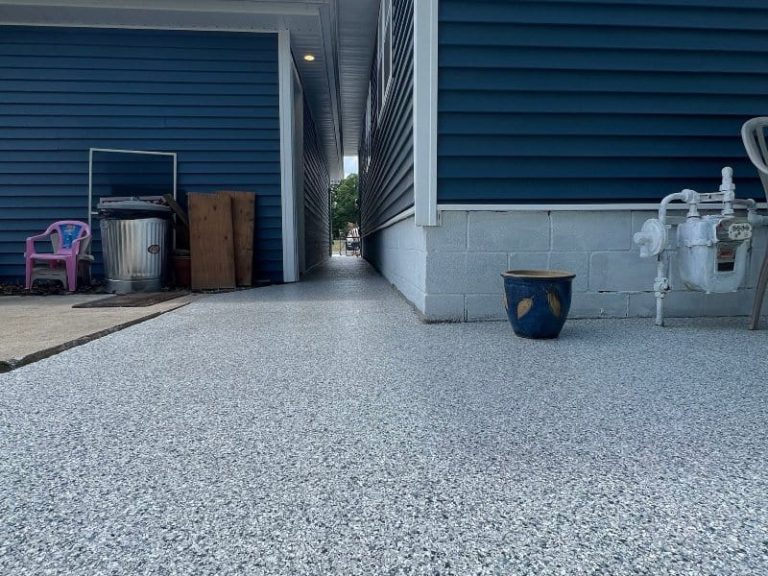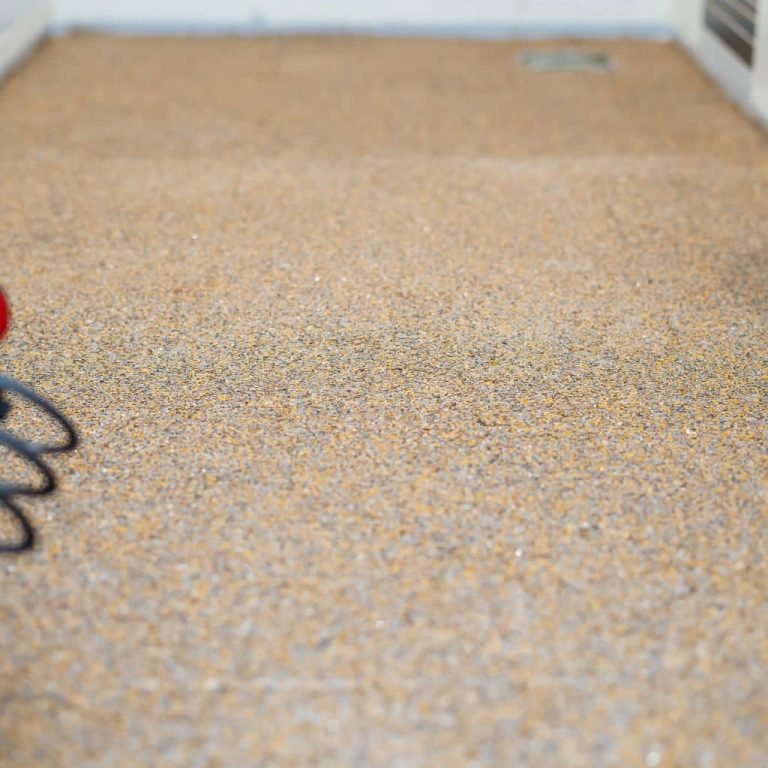When planning a garage floor upgrade, two of the most talked-about options today are epoxy and polyurea polyaspartic coatings. Homeowners want a strong, durable, and attractive floor that stands up to the rigors of daily life—think car tires, foot traffic, spills, and shifting weather conditions. But with the growing popularity of advanced polyurea coatings, you might be asking: Which system makes more sense for my budget? Which one yields better long-term performance?
In a recent interview, Level 10 Coatings expert Crayton Caudill offered insights on the cost and capabilities of both epoxy and polyurea. This article distills that advice—and adds a bit more detail—so you can make an informed choice about your garage floor or any other concrete surface you’re looking to coat. Whether you’re primarily concerned with price or searching for the most cutting-edge technology, here’s a deeper look at the strengths and drawbacks of these two leading options.
Cost Breakdown: Polyurea vs. Epoxy
Epoxy Coatings: 4 to 7 Dollars per Square Foot
Epoxy coatings have been a top choice for decades, largely due to their affordability and availability. According to Caudill, typical epoxy coatings in a residential setting can cost anywhere from 4 to 7 dollars per square foot, depending on factors such as:
- Square Footage: Large projects may qualify for volume discounts on materials and labor.
- Concrete Condition: If your floor requires repair (for instance, if it’s pitted or cracked), the prep work can raise the total price.
- Quality of Materials: DIY kits are usually cheaper, but you’ll pay more for commercial-grade epoxy systems that last longer.
- Installer’s Expertise: Professional application can boost the cost but also ensure more reliable results than a DIY approach.
The lower average price point makes epoxy appealing if you’re renovating on a tight budget or if you’re content with a mid-range solution. That said, the old adage “you get what you pay for” often holds true—higher-grade epoxy systems come closer in cost to polyurea but still tend to deliver a shorter lifespan.
Polyurea Polyaspartic Coatings: 7 to 12 Dollars per Square Foot
Polyurea coatings, often topped with a polyaspartic finish, represent the next generation in concrete-floor protection. Pricing typically falls between 7 and 12 dollars per square foot for a residential space. This extra upfront cost goes hand in hand with benefits like:
- Rapid Curing: Many polyurea systems cure in as little as a few hours, so you can walk or even drive on them sooner.
- Enhanced Durability: Polyurea is up to five times stronger than standard epoxy, showing better resistance to chemicals, abrasion, and impact.
- Longer Lifespan: With correct preparation and professional installation, you can expect a polyurea polyaspartic floor to remain in top condition for 20 years or more, far exceeding the typical 5-to-10-year range for epoxy.
- UV Stability: Polyaspartic topcoats resist yellowing from sun exposure—ideal for garages with windows or frequent door-open sunlight.
While the higher cost can give some homeowners pause, many find the increased durability and aesthetic appeal to be worth the investment. The diminished need for future repairs or re-coatings may ultimately save you money in the long run, particularly if you plan on staying in your home.
Is Epoxy or Polyurea Better?
Selecting a floor coating often comes down to balancing features like durability, appearance, maintenance requirements, and, of course, cost. When comparing epoxy and polyurea directly:
- Flexibility: Epoxy is more rigid; polyurea is more flexible. This flexibility allows polyurea to adapt to minor concrete shifts, temperature changes, and regular wear without cracking.
- Strength: Polyurea can be up to five times stronger than epoxy, meaning it’s less likely to chip, peel, or fail when exposed to heavy impacts or harsh chemicals.
- Yellowing Resistance: Epoxy frequently yellows when exposed to UV rays, while polyurea polyaspartic remains stable under sunlight. That’s especially valuable in garages with windows, partially open doors, or outdoor applications.
- Application Time: Epoxy coatings often require a multi-day process to cure thoroughly. Polyurea can sometimes be installed and fully cured within 24 hours.
Given these points, it’s no surprise that many contractors, including Caudill, often tout polyurea as the superior technology. Still, for homeowners on a budget or those who don’t mind a shorter floor lifespan, epoxy can be a viable mid-range solution—especially if you don’t expect heavy usage or intense chemical exposure.
The Downsides of Polyurea: What to Watch Out For
Despite the advantages, polyurea polyaspartic coatings aren’t perfect in every scenario. Caudill points out two primary disadvantages:
- Moisture Sensitivity: Polyurea coatings aren’t naturally moisture-tolerant. If your concrete slab has a high moisture-vapor emission rate or frequent dampness (e.g., below-grade areas without adequate vapor barriers), you’ll need to install a moisture vapor barrier first. This extra step can add both time and cost to the project.
- Thinner Application: Polyurea tends to go down a bit thinner compared to traditional epoxy. While it compensates for this with greater tensile strength and flexibility, some homeowners prefer a thicker coat because they think it looks “more solid.” In reality, the overall protection often still surpasses epoxy, but the reduced thickness can be a surprise if you’re used to seeing thick epoxy installations.
Of these two issues, moisture is the bigger deal. A coating that fails to bond due to moisture intrusion can peel prematurely, costing you even more in repairs or reapplication. Thus, an experienced installer should always assess moisture levels in the slab and recommend the best approach for your situation.
What Makes Polyurea Polyaspartic the Best Garage Floor Coating in 2025
According to Caudill, the top-tier coating for garage floors in 2025 is a polyurea base coat topped with polyaspartic. This system addresses many of the shortcomings of epoxy while delivering exceptional performance and visual appeal. Let’s break down why this approach is so effective:
1. Flexibility for Concrete Slabs
Concrete slabs naturally expand and contract with temperature fluctuations, humidity changes, and regular stress from vehicles and foot traffic. Epoxy’s rigidity can lead to cracks or peeling when subjected to these movements. Polyurea’s flexibility—and the elongation it provides—allows the coating to stretch slightly without rupturing.
2. Decorative Chip Integration
Most homeowners love the decorative chip element commonly used with polyurea systems. After applying the base coat, installers broadcast vinyl chips onto the wet surface, creating an attractive, textured layer. These chips not only add visual depth but also help disguise minor imperfections like small divots, scratches, or future wear. You can customize the color and chip density to match your personal style or complement your home’s aesthetic.
3. UV-Stable Top Coat
A polyaspartic top coat is UV stable, meaning it won’t yellow or fade from sunlight. Many epoxy floors, especially those near garage windows or under partial sunlight, can discolor over time. The UV stability of polyaspartic ensures that your new flooring looks as good a few years down the road as it did the day after installation.
4. Superior Chemical and Abrasion Resistance
From road salt to automotive fluids, a garage floor sees its fair share of corrosive or staining substances. Polyurea polyaspartic coatings excel in resisting chemical damage, whether from oil, gas, or various cleaning solutions. They’re also abrasion-resistant, so even heavy rolling tool chests, workout equipment, or other high-impact items won’t mar the surface easily.
5. Fast Installation and Cure Time
Most professional polyurea polyaspartic installations can be completed in just one day, including prep work, base coat application, and top coat. The floor is often ready for regular foot traffic the same day and can typically handle vehicle traffic within 24 hours—significantly faster than epoxy’s multiple-day curing schedule.
Additional Factors to Consider Before Choosing a Floor Coating
While polyurea polyaspartic is often described as the “best of the best,” the right coating for you also depends on these factors:
- Budget: If you have limited funds, epoxy might suffice. Just be aware that an inexpensive epoxy could fail or discolor faster, leading to higher overall costs if you need to re-coat.
- Moisture Levels: If your concrete slab is prone to moisture or if you have high humidity year-round, budget for a moisture vapor barrier to ensure your coating adheres well and avoids long-term bonding issues.
- Aesthetic Preferences: Both epoxy and polyurea can include decorative flakes, solid colors, or even metallic finishes. Polyurea tends to keep those finishes crisper over time due to better UV resistance.
- Usage Intensity: Lightly used garages or basements might do fine with epoxy, while heavily trafficked areas, commercial spaces, or frequent automotive work areas benefit more from polyurea’s superior durability.
- Installer Expertise: No matter which product you choose, a high-quality installation is crucial. Sloppy prep work can doom even the best coating. Choose an installer with a solid track record, good reviews, and transparent warranties.
How to Prepare Your Concrete for a New Coating
Surface preparation makes or breaks any floor coating project. Professionals typically use either diamond grinding or shot blasting to “roughen” the concrete surface, ensuring the coating forms a strong mechanical bond. Other steps may include:
- Crack Repair: Fill and smooth out cracks or pits with specialized repair compounds.
- Moisture Testing: Use moisture meters or specialized calcium chloride tests to measure vapor emission levels.
- Cleaning: Remove dust, oil, and other contaminants that could interfere with adhesion.
- Priming (If Needed): Some coatings require specific primers or base coats, especially if moisture is an issue.
Many DIY epoxy attempts fail because homeowners skip or rush through these steps. Even for epoxy, professional prep is essential. For polyurea, it’s non-negotiable.
Lifespan and Maintenance of Each Coating
Epoxy Maintenance
Epoxy floors usually need careful cleaning to avoid abrasive scrubbing that can dull or scratch the surface. They can also stain or develop tire marks more easily, especially if you park a hot car on them. While they resist spills and chemicals better than bare concrete, they aren’t foolproof. High-gloss epoxy can become slippery when wet, so some homeowners add anti-slip aggregates.
Polyurea Polyaspartic Maintenance
In contrast, the higher chemical and abrasion resistance of polyurea polyaspartic means you can clean up spills quickly and thoroughly with mild detergents or specialized floor cleaners. The decorative flakes also help camouflage daily dust or debris, so your floor looks cleaner between washes. Many installers include slip-resistant additives in the top coat, which can further improve safety without sacrificing aesthetics.
Deciding If the Investment Is Worth It
The difference between an epoxy floor at 4–7 dollars per square foot and a polyurea polyaspartic system at 7–12 dollars per square foot can be substantial for large garages or multiple areas. If you only plan to stay in your home a few years, an epoxy coat might suffice, giving your garage a temporary facelift. But if you envision using your garage for a decade or more—especially as a workshop, gym, or showpiece for your car collection—the added durability and longevity of polyurea polyaspartic can pay off significantly in the long run.
There’s also a potential resale boost. A well-maintained, premium-coated garage floor can set your home apart in a crowded market. Buyers appreciate walk-in-ready features that require little to no additional work. While you may not recoup the entire cost directly on the sale price, it’s often one of the details that helps your property stand out, potentially speeding up the sale process or tipping a buyer from “interested” to “ready to buy.”
Conclusion
Floor coatings, whether epoxy or polyurea polyaspartic, offer a significant upgrade over bare concrete. From added durability and easier cleaning to enhanced aesthetics, these systems can transform a mundane garage or basement into a space that looks and functions like a professional showroom. While epoxy has historically reigned as the budget-friendly go-to, the rapid rise of polyurea polyaspartic technology—offering superior strength, flexibility, UV resistance, and longevity—has changed the game for homeowners willing to invest in a more premium solution.
Yes, the 7–12 dollars per square foot for polyurea can feel like a leap compared to epoxy’s 4–7, but you’re paying for enhanced performance and fewer headaches down the road. If moisture isn’t an issue or you’re prepared to install a moisture vapor barrier, a polyurea polyaspartic floor might be the best value in the long term, giving you peace of mind and a stunning, resilient surface for 20 years or more.


